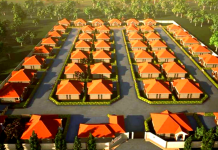Of course, topography affects architecture, no surprise there. The ground provides basic support for any building. If you are building on a highly sloped site, an architect must consider the slope of the site in determining the finish floor elevation. Additionally, if multiple entry levels will be needed to get in and out of the building.
Moreover, exits are needed in multiple locations around a large building containing more than 50 people, and if the site is highly sloped, you will really need to study the topography to understand how you can meet those elevations at the exits.
In addition, topography can add great interest to a site and to a building. For example, how the building meets the ground is an important part of the exterior design, in order to allow for the finish floor to be at or above grade, or sometimes even below it.
How does topography affect the building?
Considering if a site is flat, the topography may not influence the location and layout of the building, but on a sloping site, the topography is likely to be a significant design factor.
The slope of a site and/or the slope of adjacent sites may affect access to sun and views. For example, an east-facing hillside will have reduced afternoon and evening sunlight and depending on the height and steepness, a south-facing site may receive little or no sun during the winter months.
The location and layout of the building should be designed to minimise:
- the need for excavation or fill – as well as increasing costs, large-scale earthworks increase the risk of erosion by altering soil stability and water run-off patterns, increase sediment run-off during construction and significantly affect natural biodiversity by removing soils and plants
- the building’s footprint by using low-impact foundation systems such as pole frame construction to reduce the amount of site work and disruption
- the visual impact of the building form on the landscape.














